
AlexAnton/Shutterstock
13 Ancient Pyramids Around the World
Tourist attractions and landmarks attract millions of people yearly. Few landmarks and attractions compare with the awe-inspiring pyramids. Built by ancient civilizations, these pyramids pre-date a majority of man-built landmarks. Pyramids are easily recognizable by their unique shape and design.
The base of a pyramid is usually a polygon shape, while the exterior is a triangular shape that meets at the top. They vary in design depending on the time and region. Pyramids can be found across the globe in different countries, including Egypt, Mexico, and Italy.
In Egypt, they serve as tombs for great rulers, while in Mexico, they act as a tribute to various deities. Since many Pyramids have been around for thousands of years, they give archeologists great insight into ancient civilizations and their society, art, and population. Below are some of the oldest and most visited pyramids from around the world that are worth checking out.
13 Ancient Pyramids Around the World
1. Great Pyramid of Giza
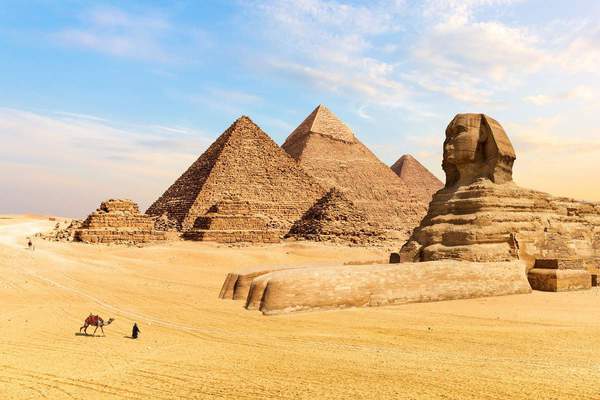
For over 4,000 years, the Great Pyramid of Giza has stood in Giza, Egypt. It’s the oldest of the Seven Wonders of the Ancient World and the largest Egyptian pyramid. Archeologists attribute the pyramid to the Fourth Dynasty pharaoh Khufu. It took roughly 27 years to build during the 26th century BC and contains the tomb of Khufu and several chambers, such as the Queen’s Chamber, The Big Void, and the King’s Chamber.
The Pyramid consists of 2.3 million blocks of local limestone from the Giza Plateau, granite blocks from Aswan, and white limestone from Tura brought in by boat on the Nile. Bound by mortar, the 6 million tons of stone create the Great Pyramid of Giza. For 3,800 years, it was the tallest structure in the world. It’s one of the most famous pyramids in Egypt and a UNESCO World Heritage Site.
2. Nubian Pyramids
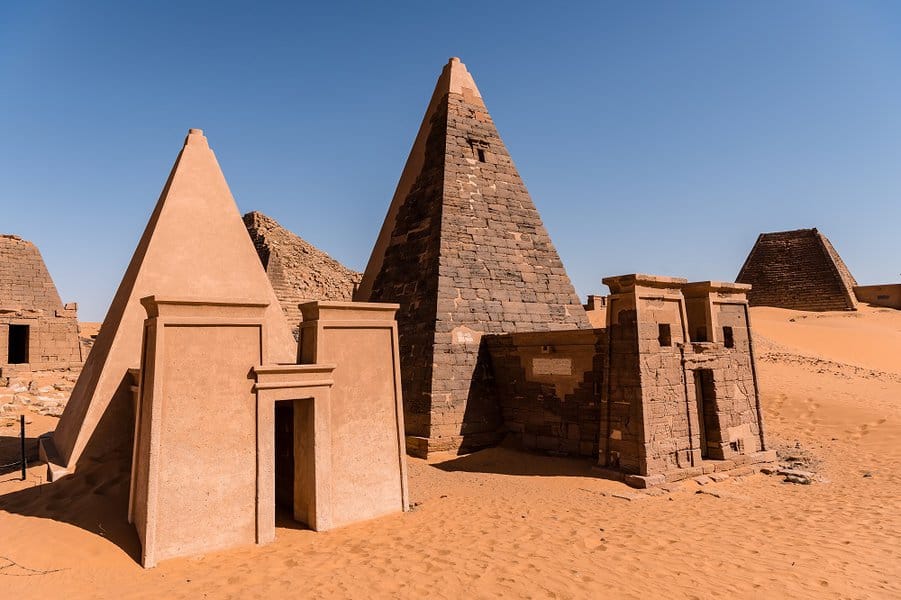
mbrand85/Shutterstock
Located in the Nubia region of the Nile Valley, what is now known as modern-day Sudan, the Nubian pyramids mimic the Egyptian pyramids that sprang up during the New Kingdom. The Nubian pyramids belonged to the rulers of the ancient Kushnite kingdoms. Each kingdom designated a different city as its capital, including Kerma, Napata, and Meroë.
The various kingdoms constructed stunning pyramids in each location, with many still standing. Some pyramids feature tombs for specific kings and queens, while a pyramid in Napata features 52 kings and queens. The pyramids consist of granite and sandstone bound together by mud bricks, plaster, and stone.
The largest of the pyramids sits in Meroë and is attributed to the Nubian queen Amanishakheto. In the 1830s, treasure hunter Giuseppe Ferlini sadly demolished 40 pyramids looking for loot, with the remaining pyramids and ruins now classified as UNESCO World Heritage sites.
3. The Pyramid of the Niches
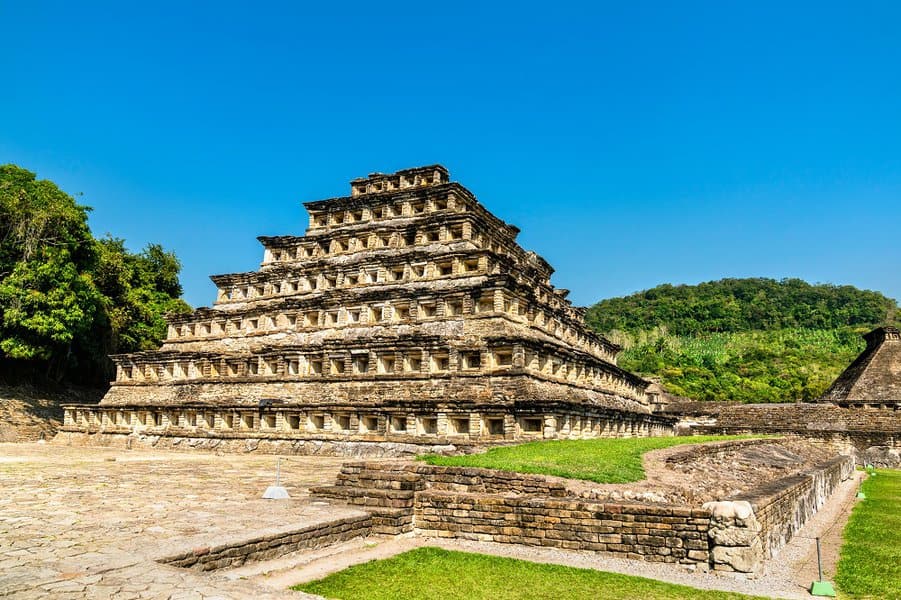
Leonid Andronov/Shutterstock
One of the most famous pyramids in the world, the Pyramid of the Niches stands in the pre-Columbian archeological site, El Tajín, in Mexico. El Tajín thrived from AD 600 to 1200, becoming an important city during the Classic era of Mesoamerica. The famous World Heritage site features several monuments, notably the Pyramid of the Niches.
The pyramid is renowned for its unique design and managed to stay largely intact over the centuries. It is made from precisely cut flagstones that fit perfectly together to reduce the use of mud and lime mortar. Also known as the Temple of Seven Stories, it features seven levels with various sculptures and decorations inside. Beneath the sacred pyramid are a series of caves with springs considered passageways to the underworld.
4. Mausoleum of the First Qin Emperor

Joshua Davenport/Shutterstock
In the early 1900s, the famous Chinese pyramids gained widespread fame. They retain the pyramidal shape but differ significantly from traditional Egyptian or Mexican pyramids. Many of these structures are burial mounds or mausoleums for early emperors of China. One of the country’s most famous pyramids is the Mausoleum of the First Qin Emperor.
Construction began in 246 BC and lasted 38 years, ending in 208 BC. The massive tomb-like city sits beneath a pyramid-shaped mound. The tomb itself divides into an outer and inner city. At the core of the mausoleum is the tomb of the famed First Qin Emperor Qin Shi Huang. The pyramid comprises rare artifacts, paintings, gold, and the Terracotta Army. Archeologists have evacuated much of the site, except the Emperor’s tomb, and tourists are able to visit the site and view parts of the incredible historical find.
5. The Pyramid of Cestius
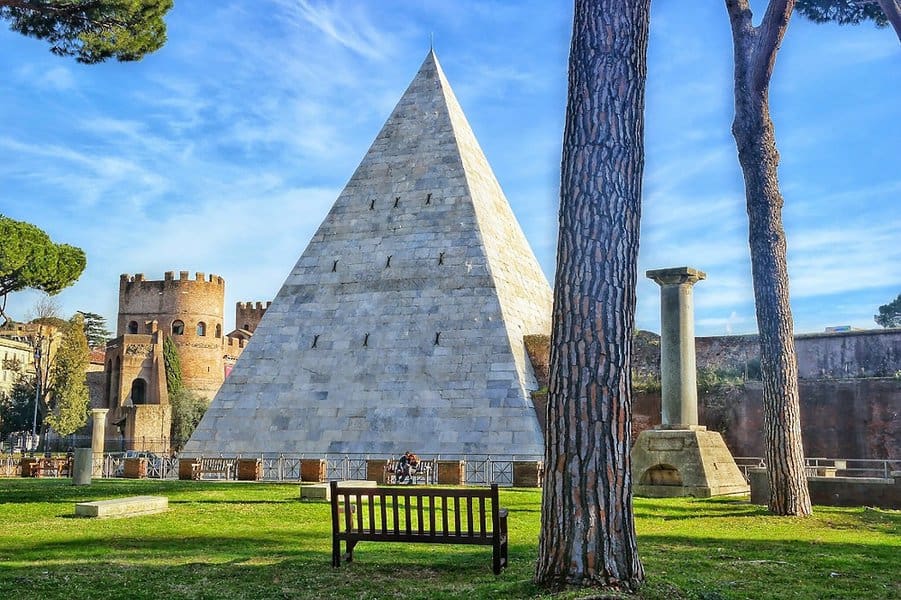
AFNery/Shutterstock
Located in Rome is the famous ancient Pyramid of Cestius. The Roman era pyramid is one of the best-maintained ancient Roman landmarks. The pyramid serves as a tomb for Gaius Cestius, a member of the Epulones religious corporation. Construction lasted from 18 BC to 12 BC, during a time when Egyptian culture was influencing Rome. It takes inspiration from the Pyramids of Nubia with its distinct shape.
Historians suspect Gaius saw the pyramids when he participated in a campaign in Nubia and decided he wanted to be buried in one. The exterior consists of white marble slabs covering brick-faced concrete. The pyramid’s interior features Gaius Cestius’ tomb, surrounded by water paintings and the base of two bronze statues.
6. Transamerica Pyramid

Jon Chica/Shutterstock
The modern Transamerica Pyramid is one of the tallest buildings in San Francisco, California. The structure is a four-sided pyramid with wings for a stairwell, smoke tower, and elevator shaft. Construction began in 1969 and finished in 1972, with the Transamerica Pyramid becoming the tallest building in the San Francisco skyline at the time. The 212-foot building features 48 floors and is one of the most popular tourist attractions in the city.
See more about - 15 Forbidden Places On Earth
7. Bent Pyramid
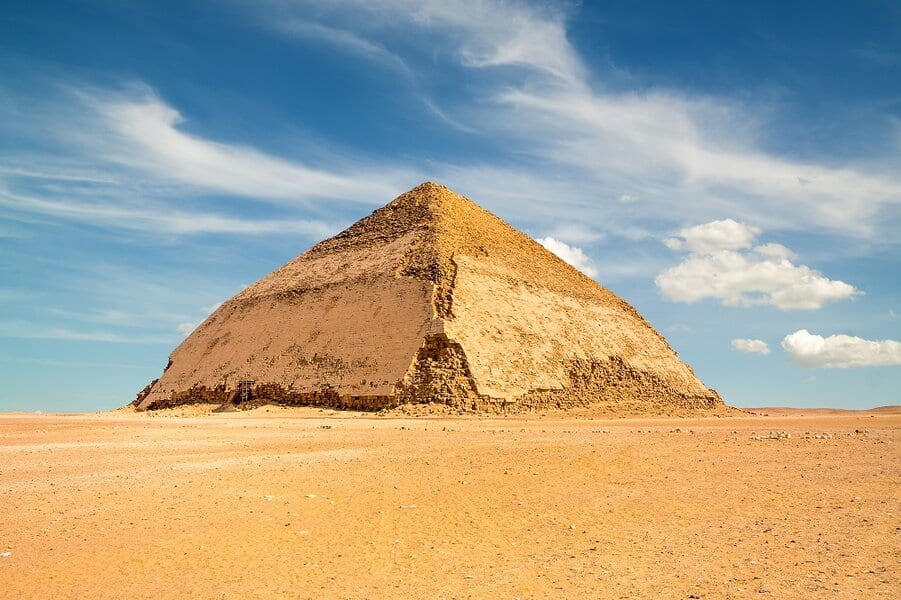
Gurgen Bakhshetyan/Shutterstock
40 kilometers south of Cairo is the famed Bent Pyramid. The ancient Egyptian pyramid is part of the royal necropolis of Dahshur. The Bent Pyramid is an early example of a pyramid, marking the transition from step-sided pyramids to the more popular and stable smooth-sided pyramids. Archeologists believe it was the second pyramid built by Pharaoh Sneferu around 2600 BC. The pyramid’s unique name comes from its unusual bent-shaped design. Constructed during the Old Kingdom, it has a 54-degree angle tilt rising from the desert.
Unlike the pyramids that followed, the top has a 43-degree angle, giving it its bent appearance. Evidence suggests the pyramid was unstable during construction due to the initial steep tilt. It was in danger of collapsing, forcing the builders to employ the shallower angle. The Pharaoh appeared to learn from the near disaster since subsequent pyramids went up at a 43-degree angle from the base instead of the top. Plus, the original limestone casing remains untouched or altered. The pyramid opened to the public in 1956, featuring a massive tunnel leading to two 4600-year-old chambers.
8. La Danta Pyramid
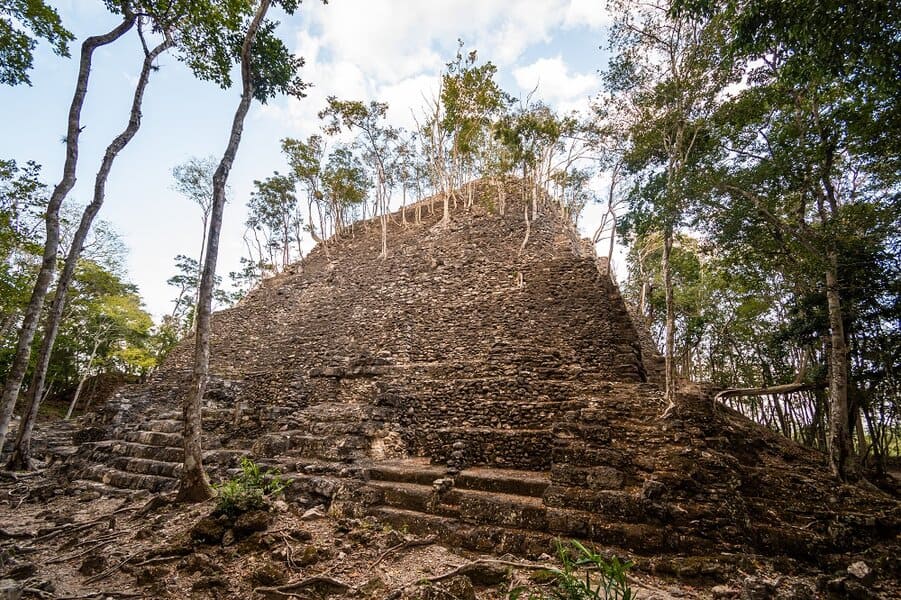
Raphael Rivest/Shutterstock
Located in El Petén, Guatemala, El Mirador was a Maya settlement from pre-Columbian in 1000 BC to the Middle and Late Preclassic era in AD 250. The colony thrived from the 6th century BC, peaking in the 3rd century BC. Around the AD 1st century, the Mayans abandoned the settlement before returning during the Late Classic period.
At the heart of the complex is the monumental temple known as La Danta. It is roughly 236 feet tall from the forest floor, with a massive artificial platform elevating it even higher. The combined height makes it one of the tallest tourist structures in the world.
9. The Pyramid of Tenayuca
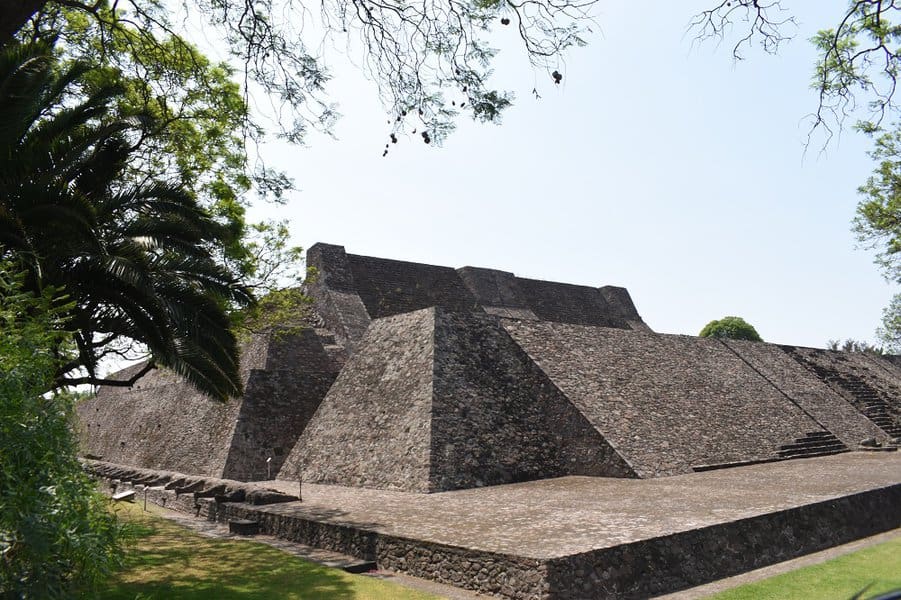
Luis Antonio Maya Orozco/Shutterstock
Like Egypt, Mexico is famous for its large number of pyramids of various designs. Aztecs built architectural marvels that still puzzle the human mind. Historians believe the legendary ruler of the Chichimec tribe, Xolotl, founded Tenayuca around 1224, although there might have been earlier settlers. Tribes constructed the pyramid through six phases at 52-year intervals.
The Aztec influence began in 1300. The double pyramid became sacred in the Aztec tradition and remained an important site until the Spanish conquest. The pyramid features dual staircases leading to a platform, with one side of the pyramid also displaying skulls with a coiled snake at the entrance.
10. The Red Pyramid
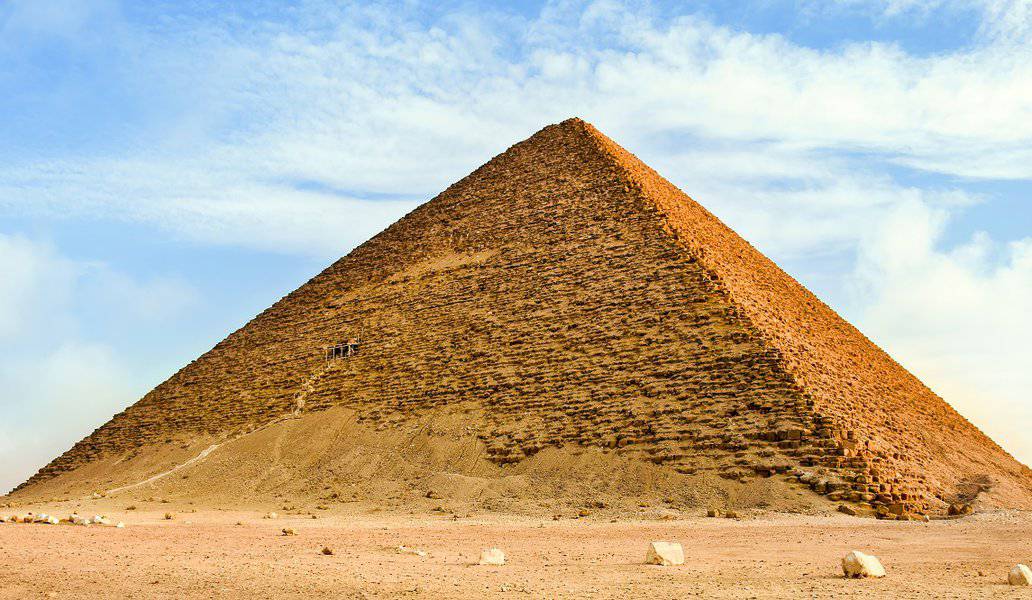
Nick Brundle Photography/Shutterstock
Archeologists now believe the Old Kingdom Pharaoh Sneferu had attempted to build the first smooth-sided pyramid. His initial attempt, The Pyramid of Medium, collapsed, and the second, the Bent Pyramid, nearly collapsed, forcing a design change. Learning from the first two attempts, Sneferuwent on to build the Red Pyramid near the Bent Pyramid in Cairo, Egypt.
Built between 2575 and 2551 BC, the pyramid has a 43-degree angle at the base and at the top, giving it a unique design. Also known as the North Pyramid, it’s the first smooth-sided pyramid and the third largest Egyptian pyramid. The name Red Pyramid comes from the red limestones used to build the pyramid, giving it a reddish hue. During the Middle Ages, locals removed the original Tura limestone, revealing the red stones underneath. It’s one of the highlights of the famous Dahshur Necropolis and an architectural marvel.
11. Temple of Kukulcán
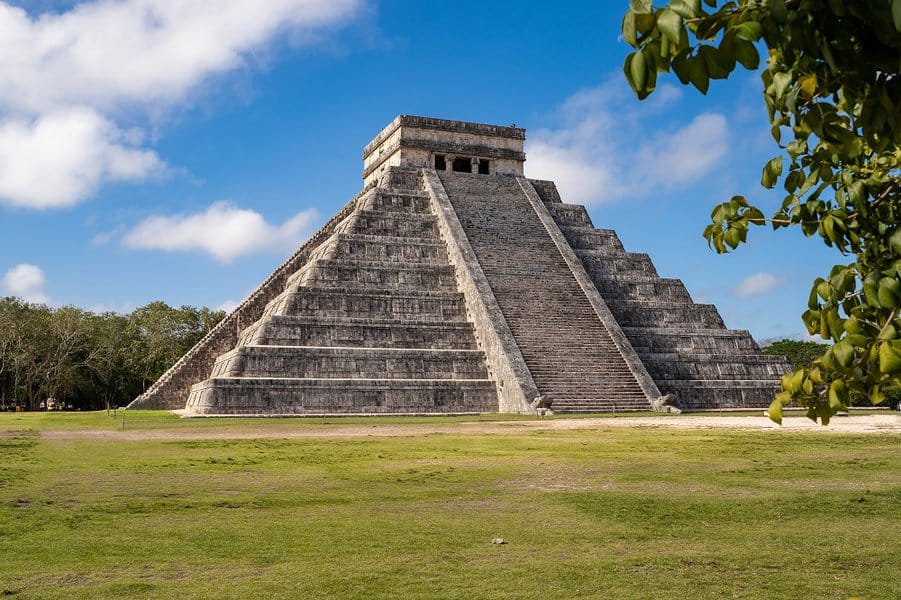
Iryna Kalamurza/Shutterstock
The world-famous Temple of Kukulcán sits in the pre-Columbian Maya city of Chichén Itzá. Located in Tinúm Municipality, Yucatán State, Mexico, it was a vital and bustling Maya city from AD 800 to 900 but declined in the 13th century.
Dedicated to the feathered serpent deity Kukulcán, the pyramid has a height of 98 feet with a large staircase. During the spring and fall equinoxes, the staircase gives the impression of a serpent descending the steps. It was common for the Maya people to build structures onto existing structures, with archeologists discovering a second temple within the Temple of Kukulcán. Inside the second pyramid, they found a red jaguar throne.
12. Pyramid of Khafre

AlexAnton/Shutterstock
The second-tallest pyramid of the Ancient Egyptian Pyramids of Giza is the Pyramid of Khafre. The tomb belonged to the Fourth Dynasty pharaoh Khafre during his reign from 2558 to 2532 BC. The famous “Middle Pyramid” stands at 136 feet, with the largest rocks at the bottom. It consisted of a Tura limestone casing with pink granite at the bottom. Unlike most pyramids of the time, the Pyramid of Khafre features two entrances leading to the burial site and other chambers.
After the end of the Old Kingdom, looters opened the pyramid robbing it of its riches. In the 19th century, the builder of the historic Heliopolis used most of the Tura limestone casing to construct a religious center. Archeologists have explored the Pyramid of Khafre, gaining valuable insight and understanding of Egyptian culture.
13. The Great Sphinx of Giza
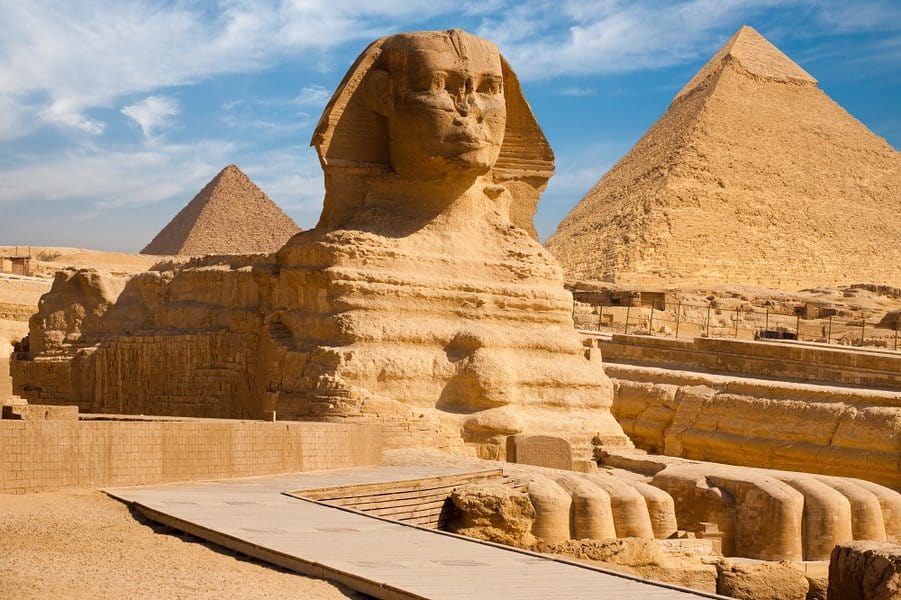
Daily Travel Photos/Shutterstock
The oldest monument in Egypt is the awe-inspiring Great Sphinx of Giza. Standing on the Giza Plateau in Giza, Egypt, the limestone sphinx is a mythical creature with the body of a lion with a human head. Despite the broken-off nose, the statue appears to depict the pharaoh Khafre, who likely commissioned the building of the Sphinx during his reign from 2558 to 2532 BC.
The Old Kingdom statue is 240 feet long and 62 feet tall. The circumstances and reasons for the broken-off nose remain a mystery. Evidence suggests the nose broke off sometime between the 3rd and 10th centuries. The original Old Kingdom name is unknown as the New Kingdom dubbed it “the Great Sphinx ” 2,000 years after its initial construction.
At one point, a large hole on the top of the head suggested a crown once sat on the Sphinx’s head. It also features a rear entrance that leads to a tunnel into the iconic statue. The 4,500-year-old statue sits with the famous Pyramids of Giza and is one of Egypt’s major tourist attractions.
See more about - 15 Of The Most Famous Unfinished Structures in Architectural History



